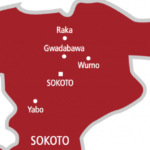If you are in Auchi then try and watch the famous hunters dance while you are there.The dance is also known locally as ‘Isiko’, and it is a crowd-puller any day. The little boy dancers who were part of the group, gave not a little colour to the effort, as well as a young two-year old girl who joined the group to dance during one of its public outings. So, there was a special contribution by the young ones, and it shows that the ‘Isiko’ performance will endure, given the enthusiasm of these young ones.
There is also the dance group known as ‘Alido’, which the visitor is adviced to watch out for. One thinks that the lovely music can gently rouse a man to good deeds. It is also very nice just to sit down to listen to this rich unforgettable music, which goes to your spirit, your very essence. No man remains the same after he has heard this music. The two groups normally perform one after the other. Last week the hunter’s danced at the palace of the Otaru during the 16th Auchi Day celebration, and they wore their nice cotton attire to the event.
The exciting dance is a simple dramatic enactment of what occurs when the group is in the thick bush in search of game, highlighting the terrors and suspense which lace such moments. The drum beats also change in keeping with the start of the chase. One man dances onto the scene. He looks about him and peers into the distance. Then he stretches forth his hand, and the audience notes that he has found game and is setting his bow and arrow for the attack. Then as the drumming intensifies, he shoots, the drumming reaches a crescendo, and the animal falls dead. The dancer now rejoices. Another dancer appears. He imitates a frightened animal which is hurrying in the bush. The animal moves around in fairly confused circles. It too is felled by a hunter and it’s all very exciting.
Quite a number of dancers appear on the scene to imitate the various animals which are regularly hunted in the thick forests of Edo State and even beyond. Here is a Lion, a Buffalo, the Elephant, the Antelope and, maybe, the Rhinoceros. The hunter’s have a vast repertoire of powerful memories to draw upon for the performance, and they use this resource, gathered over the years, and their individual talents to the maximum. Here is a celebration of the art of hunting. Another man comes on the scene and seems to be waving an imaginary gun. He suddenly stops, looks about him and aims. All this ,again, to the accompaniment of enchanting music, which is produced by lovely small drums joyfully beaten by the Isiko group .The tempo rises and falls, depending on what is being acted out. The music itself is an inspiration to dance as well as to hunt, and may suggest that the dance imbues the hunter’s with special courage for the real act of hunting itself.
Alido follows next and it is a moving piece of music. One interesting point about this performance is the bow-like musical instrument that it relies on. This produces thrilling music. The musician uses his fingers to play upon the strings. Then there is the rather small flute also blown by an artist. A box-like musical instrument is also used, known as Agidigbo in some parts of the country. This group uses indigenous musical items sourced from the bushes and forests. Alido employs a story telling format, and most of the songs relate to developments in human society.
Professor Z.I Oseni, the Waziri of Auchi, tells Weekly Trust “In Alido, there is the narration of ancient stories which cover the deeds of legendary heroes. For instance, there is the legend of Olune which often features. He is a figure with knock knees. His wife would put him in a mortar and pound him, and turn the mortar upside down as, though to prevent him from escaping. But to the surprise of his wife, Olune would be seen coming from another direction. This shows that Olune had certain great powers.” He seems to be symbolic of an inconquerable spirit or quality. There are a few female members of the group who beat the beaded gourd called Shekere in Yoruba, as well as a gong.
A few men dance here, but there is a preference for the oral narration by one of the performers. Thus the gentleman with the bow –like instrument sometimes pauses to chant or sing. Sometimes, the performer with the box-like instrument also begins to chant while the tempo of the music drops, a bit, but it never loses its loveliness however low it drops. Then that sweet music which affects you, and fills you with joy, comes again. All the instruments unite to produce this unbelievable wealth which seems to have some healing power. Alido is an example of the epic in Africa in its pure oral form. Finally, both Isiko and Alido unite to give the audience a fulfilling evening. It was time well spent at the palace of Alhaji Aliru Momoh, Otaru of Auchi, who has done a lot to revive the purer aspects of his Kingdom’s ancient culture.
 Join Daily Trust WhatsApp Community For Quick Access To News and Happenings Around You.
Join Daily Trust WhatsApp Community For Quick Access To News and Happenings Around You.


